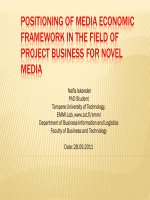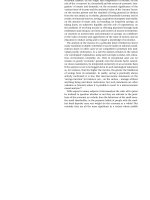Chapter 11 The Strategy of International Business
Bạn đang xem bản rút gọn của tài liệu. Xem và tải ngay bản đầy đủ của tài liệu tại đây (331.77 KB, 51 trang )
Global Business Today 6e
by Charles W.L. Hill
McGraw-Hill/Irwin
Copyright © 2009 by The McGraw-Hill
Companies, Inc. All rights reserved.
Chapter 11
The Strategy of
International Business
Introduction
Question: What actions can managers take to
compete more effectively in a global economy?
Managers must consider
the benefits of expanding into foreign
markets
which strategies to pursue in foreign markets
the value of collaboration with global
competitors
the advantages of strategic alliances
11-3
Strategy and the Firm
Question: What is strategy?
A firm’s strategy can be defined as the
actions that managers take to attain the
goals of the firm
Typically, strategies focus on profitability
and profit growth
Profitability refers to the rate of return the
firm makes on its invested capital
Profit growth is the percentage increase
in net profits over time
11-4
Strategy and the Firm
Determinants of Enterprise Value
11-5
Value Creation
Question: How do you increase the profitability
of a firm?
To increase profitability, value must be created
for the consumer
Value creation is measured by the difference
between V (the price that the firm can charge
for that product given competitive pressures)
and C (the costs of producing that product)
The two basic strategies for creating value are
1. differentiation
2. low cost
11-6
Strategic Positioning
To maximize profitability, a firm must
pick a position on the efficiency frontier that
is viable in the sense that there is enough
demand to support that choice
configure its internal operations so that they
support that position
make sure that the firm has the right
organization structure in place to execute its
strategy
So, a firm’s strategy, operations, and
organization must all be consistent with each
other in order to achieve a competitive
advantage and superior profitability
11-7
Operations: The Firm as a
Value Chain
Firms are essentially value chains
composed of a series of distinct value
creation activities, including production,
marketing, materials management,
R&D, human resources, information
systems, and the firm infrastructure
Value creation activities can be
categorized as
1. primary activities
2. support activities
11-8
Operations: The Firm as a
Value Chain
1. Primary Activities
involves creating the product, marketing
and delivering the product to buyers,
and providing support and after-sale
service to the buyers of the product
2. Support Activities
provides the inputs that allow the
primary activities of production and
marketing to occur
11-9
Operations: The Firm as a
Value Chain
The Value Chain
11-10
Classroom Performance System
All of the following are examples of primary
activities except
a) Logistics
b) Marketing and sales
c) Customer service
d) Production
11-11
Organization: The Implementation
of Strategy
Organization architecture refers to the totality of a
firm’s organization (formal organizational
structure, control systems and incentives,
organizational culture, processes, and people)
Organizational structure refers to
the formal division of the organization into
subunits
the location of decision-making responsibilities
within that structure
the establishment of integrating mechanisms to
coordinate the activities of subunits including
cross functional teams and or pan-regional
committees
11-12
Organization: The Implementation
of Strategy
Organization Architecture
11-13
Organization: The Implementation
of Strategy
Controls are the metrics used to measure the
performance of subunits and make judgments
about how well the subunits are run
Incentives are the devices used to reward
appropriate managerial behavior
Processes are the manner in which decisions
are made and work is performed
Organizational culture is the norms and value
systems that are shared among the employees
People refers to employees and the strategy
used to recruit, compensate, and retain those
individuals
11-14
In Sum: Strategic Fit
So, to attain superior performance and
earn a high return on capital, a firm’s
strategy must make sense given market
conditions
The operations of the firm must support
the firm’s strategy
The organizational architecture of the
firm must match the firm’s operations and
strategy
If market conditions shift, so must the
firm’s strategy, operations, and
organization
11-15
In Sum: Strategic Fit
Strategic Fit
11-16
Global Expansion, Profitability
and Profit Growth
Firms that operate internationally can
1. Expand the market for their domestic product offerings by
selling those products in international markets
2. Realize location economies by dispersing individual
value creation activities to locations around the globe
where they can be performed most efficiently and
effectively
3. Realize greater cost economies from experience effects
by serving an expanded global market from a central
location, thereby reducing the costs of value creation
4. Earn a greater return by leveraging any valuable skills
developed in foreign operations and transferring them to
other entities within the firm’s global network of
operations
11-17
Expanding the Market: Leveraging
Products and Competencies
To increase growth, a firm can sell products or
services developed at home in foreign markets
Success depends on the type of goods and
services, and the firm’s core competencies
(skills within the firm that competitors cannot
easily match or imitate)
Core competencies
enable the firm to reduce the costs of value
creation
create perceived value so that premium
pricing is possible
11-18
Location Economies
Firms should locate value creation activities
where economic, political, and cultural conditions
are most conducive to the performance of that
activity
Firms that successfully do this can realize
location economies (the economies that arise
from performing a value creation activity in the
optimal location for that activity, wherever in the
world that might be)
Locating value creation activities in optimal
locations
can lower the costs of value creation
can enable a firm to differentiate its product
offering from those of competitors
11-19
Location Economies
Multinationals that take advantage of location
economies create a global web of value
creation activities
Under this strategy, different stages of the value
chain are dispersed to those locations around
the globe where perceived value is maximized
or where the costs of value creation are
minimized
However, introducing transportation costs
and trade barriers complicates this picture
Political risks must be assessed when
making location decisions
11-20
Experience Effects
The experience curve refers to the systematic
reductions in production costs that have been
observed to occur over the life of a product
Studies show that a product’s production
costs decline by some quantity about each
time cumulative output doubles
Learning effects are cost savings that come from
learning by doing
Labor productivity increases when individuals
learn the most efficient ways to perform
particular tasks and management learns how
to manage the new operation more efficiently
11-21
Experience Effects
Economies of scale refer to the reductions in
unit cost achieved by producing a large volume
of a product
Sources include
the ability to spread fixed costs over a large
volume
the ability of large firms to employ
increasingly specialized equipment or
personnel
Serving a global market from a single location is
consistent with moving down the experience
curve and establishing a low-cost position
11-22
Leveraging Subsidiary Skills
To help increase firm value, managers should
recognize that valuable skills can be
developed anywhere within the firm’s global
network (not just at the corporate center)
incentive systems can encourage local
employees to acquire new skills
develop a process to identify when new skills
have been created
act as facilitators to transfer valuable skills
within the firm
11-23
Summary
Firms that expand internationally can
increase their profitability and profit
growth by
Entering markets where competitors
lack similar competencies
Realizing location economies
Exploiting experience curve effects
Transferring valuable skills within the
organization
11-24
Classroom Performance System
When different stages of a value chain are
dispersed to those locations around the
world where value added is maximized or
where the costs of value creation are
minimized, _____ is (are) created.
a) Experience effects
b) Learning effects
c) Economies of scale
d) A global web
11-25









